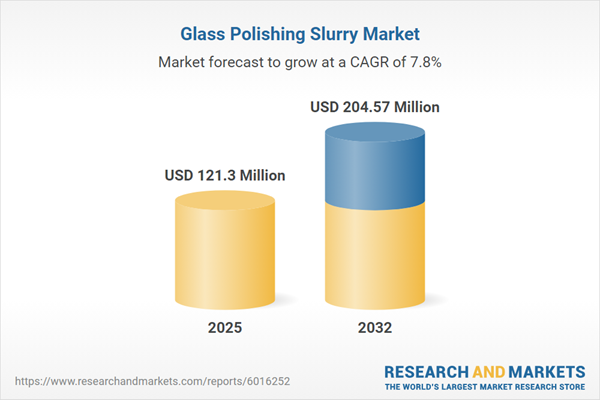Speak directly to the analyst to clarify any post sales queries you may have.
The glass polishing slurry market is evolving as advanced materials, digital integration, and increasingly demanding operational requirements drive the need for adaptable, forward-thinking approaches to stay competitive.
Market Snapshot: Glass Polishing Slurry Market Growth and Opportunity
The global glass polishing slurry market is projected to grow steadily, with a transition from USD 112.47 million in 2024 to USD 121.30 million in 2025 and a compound annual growth rate (CAGR) of 7.76%, aiming to reach USD 204.57 million by 2032. Key growth drivers include expanding use of glass components in mobile devices, increasing demand within precision optics, and more intricate needs in semiconductor manufacturing. Material science innovations, evolving regulatory frameworks, and fluctuations in global trade are enhancing industry complexity. For sustained success, organizations must refine operational accuracy, apply agile planning, and leverage adaptive supply strategies in the face of these market shifts.
Scope & Segmentation: Structure of the Glass Polishing Slurry Market
- Abrasive Types: Includes alumina, cerium oxide, and diamond grain sizes such as coarse, medium, and fine, as well as silica-based formulations. Each abrasive is engineered for compatibility with distinct manufacturing and finishing processes to match technical standards and performance needs.
- Applications: Relates to polishing LCD and OLED displays, finishing optical lenses for cameras and telescopes, producing precision glass parts, and preparing surfaces for semiconductor wafers. These applications reflect the market's diverse industrial use cases and stringent quality requirements.
- End-Use Industries: Serves multiple sectors such as automotive optics, electronics manufacturing, and both consumer and industrial optical components. The broad reach emphasizes varied procurement practices and technical compliance from different industries.
- Distribution Channels: Consists of direct sales, global distributor networks, and digital marketplace platforms. These channels streamline access to products and optimize supply chains for efficient order fulfillment and service.
- Regional Coverage: Covers North America, Latin America, Europe, the Middle East, Africa, and Asia-Pacific. Each region presents unique compliance requirements, distribution dynamics, and customer expectations, reinforcing the need for market-specific strategies.
- Key Companies Analyzed: Features industry leaders such as Cabot Microelectronics Corporation, Fujifilm Holdings Corporation, DuPont de Nemours, Inc., Merck KGaA, Entegris, Inc., Tokyo Ohka Kogyo Co., Ltd., Shin-Etsu Chemical Co., Ltd., Sumitomo Chemical Co., Ltd., 3M Company, and Saint-Gobain S.A. Their expertise shapes sector standards and technology development.
Key Takeaways: Strategic Insights for Senior Decision-Makers
- Improvements in abrasive particle engineering support reliability and higher-quality surfaces across optical and electronics manufacturing, resulting in increased process performance and reduced defects.
- Sustainable slurry solutions, such as biodegradable dispersants and closed-loop processing systems, are influencing purchasing criteria as organizations prioritize environmental responsibility and compliance.
- Digitalization, including real-time analytics and machine learning integration, enables process optimization, faster response to variability, and enhanced operational visibility throughout the production lifecycle.
- Changing trade regulations are encouraging local sourcing and domestic capacity expansion, boosting supply chain resilience and promoting cost-effective risk management for stakeholders.
- Collaboration among manufacturers, research institutions, and equipment suppliers accelerates advancements in technology, driving ongoing modernization in production and manufacturing practices.
- Market strategies tailored to regional regulatory requirements enable organizations to remain compliant and responsive to localized procurement and legislative developments.
Tariff Impact: Navigating Trade Shifts
The 2025 introduction of United States tariffs targeting imported polishing abrasives is prompting a strategic realignment of global supply chains within the glass polishing slurry sector. Manufacturers are increasingly focusing on securing local sourcing and enhancing domestic production capacities. By deepening relationships and redesigning network structures, organizations are positioned to manage risk, control expenses, and ensure business continuity. Effective sourcing flexibility and procurement agility are vital for adapting to evolving trade conditions.
Methodology & Data Sources
This analysis is grounded in extensive secondary research using recent industry publications, patent data, and regulatory documents. Expert interviews and global trade analysis inform scenario validation and deliver actionable, executive-level insights specific to the glass polishing slurry industry.
Why This Report Matters
- Guides senior leaders on technology, regulatory, and sustainability factors that shape strategic planning and resource allocation in the glass polishing slurry market.
- Presents detailed segmentation and regional analysis to support effective compliance management and adaptive supply chain strategies for changing business environments.
- Underscores the importance of digital transformation and advanced manufacturing in supporting product quality and operational efficiency.
Conclusion
Navigating complex market forces requires innovation, collaboration, and a clear regional strategy. Focusing on these drivers is critical for sustaining competitive advantage and long-term stability in the glass polishing slurry sector.
Additional Product Information:
- Purchase of this report includes 1 year online access with quarterly updates.
- This report can be updated on request. Please contact our Customer Experience team using the Ask a Question widget on our website.
Table of Contents
3. Executive Summary
4. Market Overview
7. Cumulative Impact of Artificial Intelligence 2025
Companies Mentioned
The companies profiled in this Glass Polishing Slurry market report include:- Cabot Microelectronics Corporation
- Fujifilm Holdings Corporation
- DuPont de Nemours, Inc.
- Merck KGaA
- Entegris, Inc.
- Tokyo Ohka Kogyo Co., Ltd.
- Shin-Etsu Chemical Co., Ltd.
- Sumitomo Chemical Co., Ltd.
- 3M Company
- Saint-Gobain S.A.
Table Information
| Report Attribute | Details |
|---|---|
| No. of Pages | 181 |
| Published | November 2025 |
| Forecast Period | 2025 - 2032 |
| Estimated Market Value ( USD | $ 121.3 Million |
| Forecasted Market Value ( USD | $ 204.57 Million |
| Compound Annual Growth Rate | 7.7% |
| Regions Covered | Global |
| No. of Companies Mentioned | 11 |









